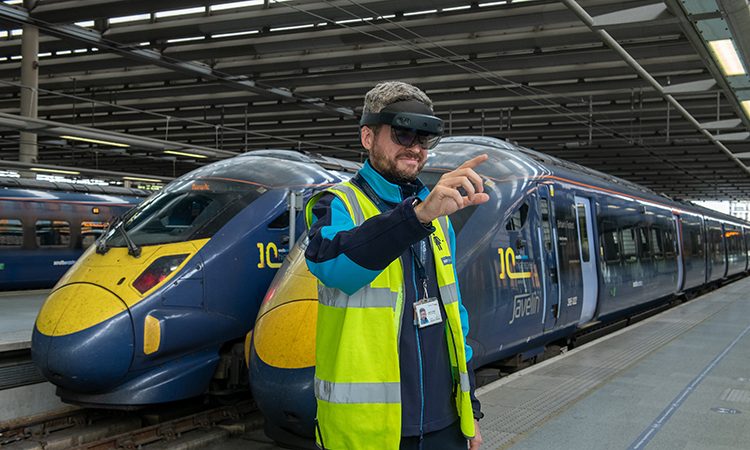Embracing innovation with augmented reality

[ad_1]
Scott Durno, Head of Technology at High Speed 1 (HS1), spoke to Global Railway Review’s Halimah Haque about HS1’s digital transformation, including the use of augmented reality for asset maintenance and improving safety in harsh weather conditions.

Credit: HS1
To start off, could you give us an overview of HS1’s digital transformation journey and what inspired the adoption of technologies like augmented reality (AR) for asset monitoring and maintenance?
I think our transformation is exciting, as HS1 is aiming to create a completely data-driven railway. As we’re privately owned, we believe the best way for us to effectively run the railway is to innovate. Our digital vision, which has been in place since 2020, influences our day-to-day operations and our long-term strategic planning.
We believe that augmented reality represents the future of understanding railway condition in relation to asset monitoring and maintenance”
Augmented reality plays a part in this vision, informing how we interact with our customers – our Train Operating Companies – as well as passengers and stakeholders.
We’ve made significant progress over the past five years including numerous trials to integrate AR into our systems and build the necessary infrastructure. As we start our next control period on 1 April 2025, we expect to see the results of these plans take shape.
At HS1 there are two core benefits for us in applying AR to our network. There’s a ‘back of house’ benefit and a ‘front of house’ benefit. The back of house refers to how we run our business, while the front of house is about interacting with our passengers to make it a more exciting journey experience.
We believe that AR represents the future of understanding railway condition in relation to asset monitoring and maintenance. Currently, engineers go out each night to inspect assets, taking photos and carrying out visual inspections without really having any data from the previous inspection. They usually record findings in paper form, which is time-consuming and inefficient in comparison to newer ways of working. With AR, engineers can access information from our asset management systems in real-time, giving them insights into the performance of an asset over time and helping them make more informed, objective decisions on-site.It’s a game changer for more effective railway maintenance and inspection.
Furthermore, AR serves as a really good way to train our staff. We’ve conducted trials where we’ve built 3D models of particular assets and provided engineers with headsets to virtually maintain and inspect them. This allows our team to become familiar with the equipment before working on the real thing, saving time and increasing efficiency.
How do you foresee augmented reality evolving beyond defect detection to impact other aspects of HS1’s asset life cycle management, and what role do you believe it will play in predictive and preventative maintenance strategies?
AR could link railway performance and station operations to customer service assistance enabling more proactive management of stations and crowds”
AR will have a significant and valuable impact across a number of areas, some of which are really high-value.
Take for example our train stations. We’ve got four international train stations, with St Pancras International the busiest, handling around 50 million passengers a year. It serves people coming in from continental Europe, the regions of the UK, the Midlands and Kent, and it connects to the London Underground and Thameslink lines, making it a highly dynamic station with constant movement.
What’s exciting is how our customer service and station operations could be transformed by augmented reality. We’ve conducted small-scale trials in the past, but we believe that, AR could link railway performance and station operations to customer service assistance enabling more proactive management of stations and crowds.
Currently, when an event occurs, such as a significant train delay, cancellation or similar, it requires reactive responses from staff. With augmented reality, staff could better manage crowds and handle events, potentially by being able to see live train performance in AR and simultaneously receive insights on how to handle it using data from past events held in our digital twin for stations. . For example, if a special event or someone famous was coming to play the piano in our station, AR could assist in managing the situation proactively.
How has augmented reality helped improve safety for HS1’s maintenance teams during harsh weather conditions, and what role do you see AR playing in enhancing safety protocols during extreme weather events, such as snow, heavy rain, or high winds?
If you combine augmented reality with remote condition monitoring and 3D asset mapping in extreme weather events, then AR can make a difference”
If you combine augmented reality with remote condition monitoring and 3D asset mapping in extreme weather events, then AR can make a difference. It means that in cold weather, at night time, with live railway zones, heavy rain, or extreme heat, maintenance can be done remotely from an office, depot, facility, or even a trackside vehicle because we have the information and geometric context of the asset.
You can see the benefit particularly when it’s unsafe for our teams to be on-site.

 Scott Durno is the Head of Technology at High Speed 1, the infrastructure owner for the Channel Tunnel Rail Link and St Pancras International, connecting London to Paris, Brussels and Amsterdam. Responsible for IT, Cybersecurity, R&D, and Asset Technology, and studying for an MSc in Digital and Technology solutions at Northeastern University, Scott is responsible for setting the strategic digital vision of the HS1 railway and ensuring that its business and asset systems deliver a high-performing railway and exceptional customer experience. Scott is an active member of tech-related industry forums and cares about promoting careers in infrastructure through technology-based careers.
Scott Durno is the Head of Technology at High Speed 1, the infrastructure owner for the Channel Tunnel Rail Link and St Pancras International, connecting London to Paris, Brussels and Amsterdam. Responsible for IT, Cybersecurity, R&D, and Asset Technology, and studying for an MSc in Digital and Technology solutions at Northeastern University, Scott is responsible for setting the strategic digital vision of the HS1 railway and ensuring that its business and asset systems deliver a high-performing railway and exceptional customer experience. Scott is an active member of tech-related industry forums and cares about promoting careers in infrastructure through technology-based careers.





